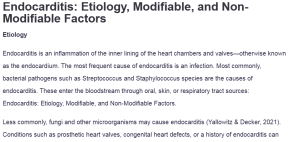Endocarditis: Etiology, Modifiable, and Non-Modifiable Factors
Etiology
Endocarditis is an inflammation of the inner lining of the heart chambers and valves—otherwise known as the endocardium. The most frequent cause of endocarditis is an infection. Most commonly, bacterial pathogens such as Streptococcus and Staphylococcus species are the causes of endocarditis. These enter the bloodstream through oral, skin, or respiratory tract sources: Endocarditis: Etiology, Modifiable, and Non-Modifiable Factors.
Less commonly, fungi and other microorganisms may cause endocarditis (Yallowitz & Decker, 2021). Conditions such as prosthetic heart valves, congenital heart defects, or a history of endocarditis can predispose an individual to this disease. Invasive medical and dental procedures introduce pathogens directly into the blood, initiating the disease.
Modifiable Factors
Several modifiable factors influence the risk of developing endocarditis. One of the most important is oral hygiene, as increased bacterial colonization in the mouth leads to bacteremia. Another important modifiable factor is intravenous drug use; sharing needles means pathogens have a direct entry into the bloodstream.
Additional risks can be removed with proper management of chronic conditions like diabetes and avoidance of tattooing or body piercings in unsterile environments. Antimicrobial prophylaxis during medical or dental procedures is an established prevention measure for high-risk individuals (Rajani & Klein, 2020).
Non-Modifiable Factors
Equally important are the non-modifiable factors in the risk of endocarditis. Among these are structural abnormalities of the heart, such as congenital disabilities or rheumatic heart disease, which predispose. Advanced age is another crucial factor since degenerative changes in heart valves are more common in the older adult population.
Other substantial non-modifiable risks include prosthetic valves and a history of endocarditis. Also, genetic disorders such as Marfan syndrome predispose people to this condition (Yallowitz & Decker, 2021).
Conclusion
Understanding endocarditis’s etiology and risk factors is very important for its prevention and management. Modifiable risk factors, such as oral hygiene and intravenous drug use, and adhering to prophylactic measures can dramatically reduce the risk; early recognition and intervention are especially important in high-risk populations.
References
Rajani, R., & Klein, J. L. (2020). Infective endocarditis: A contemporary update. Clinical Medicine, 20(1), 31–35. https://doi.org/10.7861/clinmed.cme.20.1.1
Yallowitz, A. W., & Decker, L. C. (2021). Infectious Endocarditis. PubMed; StatPearls Publishing. https://pubmed.ncbi.nlm.nih.gov/32491573/
ORDER A PLAGIARISM-FREE PAPER HERE
We’ll write everything from scratch
Question 
Discussion Post
Heart disease remains one of the top causes of mortality in the Unites States. Consider the various types of heart disease covered in class this week. For your discussion, complete these items:
- The etiology of the selected heart disease
- Modifiable factors
- Non-modifiable factors
- ENDOCARDITIS: For the disease to talk about
- Endocarditis, an inflammation of the inner lining of the heart chambers and valves
Use at least one scholarly source to support your findings. Examples of scholarly sources include academic journals, textbooks, reference texts, and CINAHL nursing guides. Be sure to cite your sources in-text and on a References page using APA format.

Endocarditis: Etiology, Modifiable, and Non-Modifiable Factors
You can find useful reference materials for this assignment in the School of Nursing guide: https://guides.rasmussen.edu/nursing/referenceebooks
Have questions about APA? Visit the online APA guide: https://guides.rasmussen.edu/apa
Client’s Notes:
- RESPOND TO THIS POST: